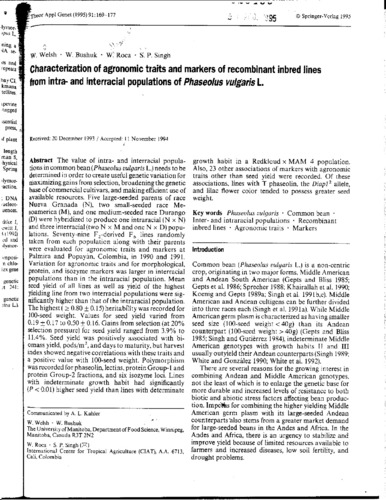Characterization of agronomic traits and markers of recombinant inbred lines from intra-and interracial populations of Phaseolus vulgaris L.
The value of intra- and interracial populations in common bean (Phaseolus vulgaris L.) needs to be determined in order to create useful genetic variation for maximizing gains from selection, broadening the genetic base of commercial cultivars, and making efficient use of available resources. Five large-seeded parents of race Nueva Granada (N), two small-seeded race Mesoamerica (M), and one medium-seeded race Durango (D) were hybridized to produce one intraracial (N x N) and three interracial (two N x M and one N x D) populations. Seventy-nine F2-derived F6 lines randomly taken from each population along with their parents were evaluated for agronomic traits and markers at Palmira and Popayán, Colombia, in 1990 and 1991. Variation for agronomic traits and for morphological, protein, and isozyme markers was larger in interracial populations than in the intraracial population. Mean seed yield of all lines as well as yield of the highest yielding line from two interracial populations were significantly higher than that of the intraracial population. The highest (? 0.80±0.15) heritability was recorded for 100-seed weight. Values for seed yield varied from 0.19±0.17 to 0.50±0.16. Gains from selection (at 20% selection pressure) for seed yield ranged from 3.9% to 11.4%. Seed yield was positively associated with biomass yield, pods/m2, and days to maturity, but harvest index showed negative correlations with these traits and a positive value with 100-seed weight. Polymorphism was recorded for phaseolin, lectins, protein Group-1 and protein Group-2 fractions, and six isozyme loci. Lines with indeterminate growth habit had significantly (P < 0.01) higher seed yield than lines with determinate growth habit in a Redkloud x MAM 4 population. Also, 23 other associations of markers with agronomic traits other than seed yield were recorded. Of these associations, lines with T phaseolin, the Diap1 2 allele, and lilac flower color tended to possess greater seed weight.

